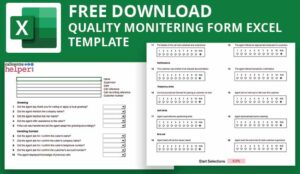In this article Paul Pember shares some key ingredients of call evaluation and how to make it fresh, engaging and something that will support advisors to deliver the best possible customer experience.
Call evaluation, call listening or call audits, whatever you call it, it’s the process of listening to advisors’ conversations with customers to ensure they are reaching the expected and desired quality.
It’s one of the most critical activities within contact centres; however, its importance can sometimes be overlooked. As we continue deep into the digital age, calls are becoming less transactional and more complex.
Therefore, it’s more vital than ever for organizations to have effective call evaluation criteria and systems in place.
Before we dive into the best call evaluation criteria, it’s critical to be clear on the outcomes you’re hoping to achieve from evaluating calls.
The why? This is vital because without the ‘why’, you may fall into the trap where the call evaluations become a tick-box activity and lose value over time, with team leaders seeing it as just another thing they have to do.
The Key Outcomes From Call Evaluations Are:
- To ensure advisors are handling customer conversations to the defined standards
- To pinpoint training gaps at an advisor and team level
- To support team leaders to coach advisors as the evaluations give actionable insight and feedback, based on real customer conversations
- To help gain insight and identify ideas for improvements to the customer experience through hearing the issues and frustrations from the customer directly
With the outcomes now defined, it’s easier to develop what the best call evaluation criteria should be.
Seven Features of Effective Call Evaluations
1. A Clear and Effective Scoring System
This underpins the call evaluation as it enables an objective grading and supports consistency across the contact centre. Having a score gives each advisor a clear understanding of their performance from a quantitative perspective, which is something you can monitor, track and reward on.
In addition, you’ll want qualitative insight, which is the in-depth feedback on what areas they need to develop to increase their score. I’ll expand on this further in my next point.
Benefits of a scoring system
- Gives team managers a view of scores across the team, which enables them to more strategically manage their teams in terms of succession planning, peer-to-peer coaching placements and evidence-based performance management
- Aligns reward and recognition with the call evaluation scores. This supports the fairness and equality agenda as the recognition is based on an objective framework rather than favourites in the team
- You can report and analyse the call evaluation scores at an individual and multi-team level. This allows for monitoring progress and gaining a strategic view of development and training needs across the contact centre
Read our article 4 Different Approaches to Quality Scoring for suggestions on how to create an effective scoring system.
2. Stop, Start & Continue Model to Support the Coaching Conversations
This part plays a critical role in supporting team leaders to prepare for their coaching conversations with advisors. Without these qualitative insights from the call evaluations, the advisor will find it difficult to understand what specifically they need to improve and develop on.
The Stop, Start & Continue (SSC) model is a framework designed to facilitate structured and effective coaching conversations. It helps team leaders provide advisors with clear, actionable feedback based on qualitative insights gathered from call evaluations or other performance assessments.
- Stop: Identifies behaviors or practices the advisor should cease because they are unproductive, counterproductive, or misaligned with goals.
- Start: Highlights new behaviours or strategies the advisor should begin adopting to improve performance or address specific gaps.
- Continue: Reinforces effective practices the advisor is already employing successfully and should maintain.
By organizing feedback into these three categories, the SSC model simplifies complex insights into a format that is easy for advisors to understand and act upon. It also supports ongoing monitoring and progress tracking, ensuring that advisors can focus on continuous improvement.
In addition, SSC can support cultural customer-centric change, as the model can include feedback and insights on advisor behaviour and attitude, rather than just being focused on policy, process and knowledge.
3. Human Skills (Emotional Intelligence) – Kindness, Empathy and Building a Connection
It is very easy for the advisor to slowly become process focused.
With most advisors taking a large number of calls each day, it is very easy for them to slowly become process focused, second guessing the customer issue and not spending time investing in the conversation on a human level.
This is a really critical part of the criteria, and without this, your organization misses an opportunity to build a deep relationship with your customers. It could be as easy as the advisor being able to relate to the customer, or acknowledging the difficult or frustrating situation they are in.
Human skills can be seen as a little subjective. How do you evaluate and coach advisors on this?
- Embed emotional intelligence within your recruitment process. This ensures you’re getting the right person into your organization who demonstrates the human skills you want when interacting with your customers.
- Have a continued focus on emotional intelligence within your onboarding
- Develop different scenarios for advisors to discuss how emotional intelligence can be used to support the conversation
- Link reward and recognition to advisors who demonstrate emotional intelligence in customer conversations
To find out more about how to effectively reward and recognize your staff, read our article: How to Make the Most of Your Staff Incentives – With Examples
4. Active Listening
This could be placed within ‘Human Skills’; however, it deserves its own standing. Active listening is the act of truly paying attention to what the customer is saying and how they are saying it. If advisors aren’t actively listening, then they won’t be able to personalize and adapt their response.
Instead, they’ll hear a few key words from the customer and jump straight into response mode, without fully understanding the context of the conversation.
Customers don’t like having to repeat information more than once, especially if it’s a personal issue around health or finances. Active listening is one of the key levers in moving away from a process- to a customer-centric culture within the contact centre.
5. Human and Authentic Voice and Language
This isn’t about ensuring everyone conforms to a strict set way, as it’s all about being human and authentic. However, it is important to ensure the tone of voice is appropriate. This includes ensuring the volume isn’t too loud or too quiet and that the speed doesn’t make the customer feel rushed.
The language advisors use in the conversation is really important. Using positive, reassuring and customer-friendly language will make a real difference to how the customer perceives the interaction and ultimately their feeling towards the organization.
Customers don’t want to hear internal organization acronyms or technical language. The example below illustrates:
Scenario: Customer hasn’t received their delivery and calls the contact centre
Advisor A: responds with uncertain words such as ‘not sure why that’s happened’, ‘hopefully I can sort it for you’, ‘our delivery partners are so unreliable’, ‘I’m just going to input this into our XYZ system’
Advisor B: responds with reassuring and positive words, such as ‘I’m sorry this has happened to you. Don’t worry I’ll get this sorted for you’, ‘this happens from time to time, rest assured we’ll get this fixed for you’, ‘I’m going to add some details into our system now so we can get this sorted for you’
These subtle changes in language have a real impact on the customer’s confidence and trust in the organization being able to fix the delivery issue.
6. Issue Resolution, Product and Service Knowledge
This criterion underpins everything. Without it, you may end up with friendly and emotionally intelligent advisors who can’t actually help customers when they contact you.
Customers have contacted you for a reason; they either want to ask or do something and have made contact to get it sorted. Therefore advisors need to have expertise in the products and services that the organization offers, and the processes that sit behind them.
This expert knowledge will not only give customers assurance and trust that the organization knows what it’s doing, but will also improve employee engagement due to them feeling confident in the knowledge and having the reward of being able to support customers who contact.
Read our article 14 Practical Techniques to Improve Knowledge Management for recommended techniques to improve knowledge management, while also boosting the customer and advisor experience.
7. Conversation Flow
The ability to control a conversation can enable advisors to have an effective value-add interaction and can be the difference between a good and a great conversation.
The advisor’s role is to effortlessly guide the customer through the interaction, from issue to resolution – ensuring the conversation isn’t full of silences or uncertainty.
The conversation flow is made up of several parts:
- Query identification (understanding why the customer is contacting the organization)
- Query support (sharing knowledge and information about the query resolution)
- Query resolution (this can sometimes happen during the conversation and is the action of either the advisor or the customer resolving the query)
- Summarizing (ensuring the customer is satisfied and clear on what has happened and what the next steps are, if any)
Other Useful Things for Call Evaluation:
- Have a system in place that enables team leaders to highlight calls that could be used for future training and coaching sessions
- Have the ability to highlight calls that deserve a reward and recognition
- Make it visual, engaging and easy for advisors to access
- Co-create your call evaluation framework with your advisors
- Review regularly and have workshops to ensure consistency across the contact centre

Paul Pember
Used in the right way, call evaluations can be an engaging, positive and even fun activity.
It can be a tool to enable customer-centric cultural change and move away from process to customer experience.
It can support advisors to understand the ingredients of a great conversation and enables them to understand specific areas they need to develop.
On the other hand, call evaluations can be seen as another tool for ‘management’ to monitor, check and catch advisors out, creating a culture of fear. How do your advisors view your call evaluations?
Thanks to Paul Pember, a customer service specialist, for putting together this article. To read more from Paul read our articles:
- 9 Traits of High-Performing Team Leaders
- 6 Things to Have in Place for Successful Hybrid Working
- Going From Induction to Onboarding
Author: Paul Pember
Reviewed by: Robyn Coppell
Published On: 13th Oct 2021 - Last modified: 29th Nov 2024
Read more about - Customer Service Strategy, Call Quality, Coaching, Metrics, Monitoring, Paul Pember




































